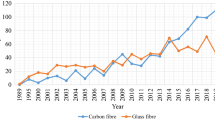Abstract
The purpose of this study was to develop new composites of glass-ceramics from hazardous Cr-Zn galvanic sludge (up to 30%), spent foundry sand (25%), glass rejects from metal surface cleaning (20%), and natural red clay (25%) to produce environmentally clean ceramics. All the raw materials and the developed ceramics were analyzed by XRF, XRD, DTA and TGA, SEM, AAS, and LAMMA. The ceramics showed very high flexural resistance (up to 22.84 MPa) and low values of linear shrinkage (5.02%), water absorption (3.20%), and bulk density (2.00 g/cm3) after sintering at temperatures of 950–1200 °C for 1 h. The solubility and leaching of heavy metals from the developed composites with 75% of industrial wastes were far below Brazilian standards, which makes them eco-friendly materials. Such properties allow the use of the ceramics for the production of facing tiles, roof tiles, blocks, and bricks with high economic efficiency.






Similar content being viewed by others
References
Alves LC, Seo ESM (2014) Characterization of the solid residue from the process for environmental economic valuation. J Environ San Eng 19:423–434. https://doi.org/10.1590/S1413-41522014019000000637 (in Portuguese)
Bhimani DR et al (2013) A study on foundry sand: opportunities for sustainable and economical concrete. J Int Glob Res Anal 2:1 https://www.worldwidejournals.com/global-journal-for-research-analysis-GJRA/file.php?val=January_2013_1358501392_37069_25.pdf
Bratskaya SY et al (2009) Heavy metals removal by flocculation/precipitation using N-(2-carboxyethyl) chitosans. J Colloids Surf A 339:140–144. https://doi.org/10.1016/j.colsurfa.2009.02.013
Brown ME, Gallagher PK (2011) Handbook of thermal analysis and calorimetry: recent advances, techniques and applications. Elsevier. https://books.google.com.br/books?hl=pt-BR&lr=&id=0TjcPYVDNSEC&oi=fnd&pg=PP1&dq=Brown,+M.E.,+Gallagher,+P.K.,+2011.+Handbook+of+thermal+analysis+and+calorimetry:+recent+advances,+techniques+and+applications.+Elsevier.&ots=yCvG1P6pul&sig=HsrSS4CrQOPWCSv-WXMNzVoYUUg#v=onepage&q=Brown%2C%20M.E.%2C%20Gallagher%2C%20P.K.%2C%202011.%20 Handbook%20of%20thermal%20analysis%20and%20calorimetry%3A%20recent%20advances%2C%20techniques%20and%20applications.%20Elsevier.&f=false
Cui J, Zhang L (2008) Metallurgical recovery of metals from electronic waste: review. J Hazard Mater 158:228–256 https://www.sciencedirect.com/science/article/pii/S0304389408002161?via%3Dihub
Deubener, J., et al, 2018. Updated definition of glass-ceramics J. Non-Crystalline Solids501, 3–10. https://doi.org/10.1016/j.jnoncrysol.2018.01.033
Economou-Eliopoulos M (2017) Geochemical constraints on the sources of Cr (VI) contamination in waters of Messapia (Central Evia) Basin. J Appl Geochem 84:13–25. https://doi.org/10.1016/j.apgeochem.2017.05.015
Erdem M, Tumen F (2004) Chromium removal from aqueous solution by the ferrite process. J Hazard Mater 109:71–77. https://doi.org/10.1016/j.jhazmat.2004.02.031
Furlani E et al (2014) Preparation and characterization of sintered ceramics made with spent foundry olivine sand and clay. J Ceram Int 38:2619–2625. https://doi.org/10.1016/j.ceramint.2011.11.065
Johnson DW, Gallagher PK (1971) Kinetics of the decomposition of freeze-dried aluminum sulfate and ammonium aluminum sulfate. J Am Ceram Soc 54:461–465
Kato E et al (1981) Decomposition of two aluminum sulfates and characterization of the resultant aluminas. J Am Ceram Soc 64(8):436–443
Levitskii IA, Poznyak AI (2015) Thermophysical characteristics of furnace tiles obtained using galvanic production wastes. J Glass Ceram 72:130–134
Magalhaes JM et al (2004) Physical and chemical characterization of metal finishing industrial wastes. J Environ Manag 75:157–166. https://doi.org/10.1016/j.jenvman.2004.09.011
Magalhães JM et al (2005) Role of the mixing conditions and composition of galvanic sludges on the inertization process in clay-based ceramics. J Hazard Mater 106:169–176
Maryandyshev PA et al (2016) Thermal decomposition and combustion of coals, fuel wood, and hydrolytic lignin, as studied by thermal analysis. J Solid Fuel Chem 50:167–176. https://doi.org/10.3103/S0361
Matos PR et al (2019) Novel applications of waste foundry sand in conventional and dry-mix concretes. J Environ Manag 244:294–303. https://doi.org/10.1016/j.jenvman.2019.04.048
Miguel RE et al (2012) Analysis of total metals in waste molding and core sands from ferrous and non-ferrous foundries. J Environ Manag 110:77–81. https://doi.org/10.1016/j.jenvman.2012.05.025
Mymrin V. Industrial and municipal wastes utilization as economical and environment efficient raw materials. http://paginapessoal.utfpr.edu.br/mymrinev. Accessed 18 March 2012. (in Portuguese)
Mymrin V et al (2013) Oily diatomite and galvanic wastes as raw materials for red ceramics fabrication. Constr Build Mater 41:360–364. https://doi.org/10.1016/j.conbuildmat.2012.11.041
Mymrin V et al (2016) Influence of kaolin clay on mechanical properties and on the structure formation processes of white ceramics with inclusion of hazardous sewage sludge. J Appl Clay Sci 155:95–102. https://doi.org/10.1016/j.clay.2018.01.006
NBR 10.004 (2004) Solid wastes - classification. Rio de Janeiro, 2004 (in Portuguese)
NBR 15270-3/05 (2005) Flexural rupture strength and water adsorption measurement of ceramic bricks, Rio de Janeiro (in Portuguese)
Nishida T et al (2000) Solidification of hazardous heavy metal ions with soda-lime glass—characterization of iron and zinc in the waste glass. J Ceram Soc Jpn 108:245–248
Novak M et al (2017) Chromium isotope fractionations resulting from electroplating, chromating and anodizing: implications for groundwater pollution studies. J Appl Geochem 80:134–142. https://doi.org/10.1016/j.apgeochem.2017.03.009
Pérez-Villarejo L et al (2012) Manufacturing new ceramic materials from clay and red mud derived from the aluminum industry. Constr Build Mater 35:656–665. https://doi.org/10.1016/j.conbuildmat.2012.04.133
Pytel Z (2014) Evaluation of potential applications of recycled moulding and core sands to production of ceramic building materials. J Ceram Int 40:4351–4358
Raupp-Pereira F et al (2007) Extrusion and property characterisation of waste-based ceramic formulations. J Eur Ceram Soc 275:2333–2340. https://doi.org/10.1016/j.jeurceramsoc.2006.07.015
Sethu VS, Aziz AR, Aroua MK (2008) Recovery and reutilization of copper from metal hydroxide sludge. J Clean Technol Environ Policy 10:131–136. https://doi.org/10.1007/s10098-007-0133-4
Verheijen OS (2003) Thermal and chemical behavior of glass forming batches. Technische Universiteit Eindhoven. https://doi.org/10.6100/IR565202
Vilarinho C, Ribeiro FA (2011) Small sized pilot scale experiments on the recovery cooper and nickel hydroxide from galvanic sludge. http://hdl.handle.net/1822/14997
Warchulski R et al (2019) Rainwater-induced migration of potentially toxic elements from a Zn–Pb slag dump in Ruda Śląska in light of mineralogical, geochemical and geophysical investigations. J Appl Geochem 109:104396. https://doi.org/10.1016/j.apgeochem.2019.104396
Zhang W et al (2018) Crystallization mechanism and properties of glass ceramics from modified molten blast furnace slag. J Non-Cryst Solids 502:164–171. https://doi.org/10.1016/j.jnoncrysol.2018.08.024
Zhenget WM et al (2019) Thermal process and mechanism of phase transition and detoxification of glass-ceramics from asbestos tailings. J Non-Cryst Solids 517:26–31. https://doi.org/10.1016/j.jnoncrysol.2018.10.029
Acknowledgments
The authors are grateful to the staff from the Laboratory of Analyses of Minerals and Rocks (LAMIR) of Federal University of Paraná, Curitiba, Brazil, for technical support in providing chemical and mineralogical analyses.
Author information
Authors and Affiliations
Corresponding author
Additional information
Publisher’s note
Springer Nature remains neutral with regard to jurisdictional claims in published maps and institutional affiliations.
Rights and permissions
About this article
Cite this article
Mymrin, V., Borgo, S.C., Alekseev, K. et al. Galvanic Cr-Zn and spent foundry sand waste application as valuable components of sustainable ceramics to prevent environment pollution. Int J Adv Manuf Technol 107, 1239–1250 (2020). https://doi.org/10.1007/s00170-020-05066-7
Received:
Accepted:
Published:
Issue Date:
DOI: https://doi.org/10.1007/s00170-020-05066-7




